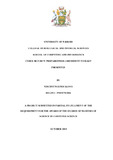| dc.description.abstract | The internet is becoming an important thing in people’s daily life and has grown at an
explosive rate. According to GlobalWebIndex (2018), internet users (population) around
the world are over 4 billion, which corresponds to almost 53% of the world’s population.
In the developing countries, people who use internet is around 31% of the population,
compared with 77% in the developed countries. Nonetheless, in Kenya, Internet usage is
at 52%, well above the ITU average for developing countries. This can be explained by
high mobile penetration in Kenya which stands at 90.4% according to the Communication
Authority of Kenya (CA). The Internet usage purposes bring both advantages and
disadvantages for people and their community. In this research we focus on the downside
which includes illegal content, online fraud, identity theft, espionage, sabotage, cyber
terrorism, and cyber stalking. While many organizations would not wish to have their
information exposed to unauthorized audiences, they also face the challenge that they
cannot do meaningful business today without automation of their services. This therefore
underscores the position of ensuring that while they go online, they are also guaranteed
that their data is secure, which leads to the fact that organizations should take the concept
of cyber security seriously. To deal with this predicament, advisory organizations are
promoting a more proactive and adaptive approach. This has necessitated
recommendation of various frameworks such as National Institute of Standards and
Technology (NIST) and Control Objectives for Information and Related Technologies
(COBIT) that can help organizations navigate through the complex landscape of cyber
security with a shift toward continuous monitoring and real-time assessments. The
challenge then comes on how organizations can apply these standards in a cost-effective
manner that allows them to be guaranteed of being cyber security ready. | en_US |



